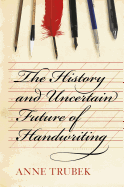
In The History and Uncertain Future of Handwriting, Anne Trubek (A Skeptic's Guide to Writers' Houses) explores the development of handwriting--physical and cultural--from clay tablets and cuneiform in ancient Mesopotamia to its role in the world of digital communication.
Trubek describes changes in the technology of handwriting. (Making a quill pen is more complicated than you may realize.) More importantly, she considers the political and social implications inherent in who learned to write, what they recorded and the scripts they used. She traces the relatively late rise of the notion that a person's handwriting is an unusual production, and ties the idea that handwriting is a reflection of personality to pseudosciences such as phrenology and eugenics.
Some of the most interesting sections arise from the recurring fear that innovations in writing technologies, such as the printing press and the typewriter that threatened to replace it, would prove detrimental to the intellectual abilities of future generations embracing them. Handwriting itself was the target of impassioned attacks by Socrates and his followers, who believed the written word would destroy not only the ability to remember but also the ability to think complex thoughts.
Trubek never loses sight of the fact that handwriting is a controversial subject today. Throughout her history, she offers amusing and insightful comparisons between past and present, preparing the reader for a final discussion of the future of handwriting. The result is a light-handed and thoughtful account of a complicated subject. --Pamela Toler, blogging at History in the Margins

